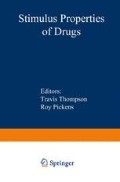Abstract
Morphine is the principle derivative of opium and the prototypic opiate for a great deal of pharmacologic investigation. One way to examine the significance of the behavioral properties of morphine and other opiates is to investigate the manner in which they modify and strengthen behavior. If intravenous morphine or other opiates are presented immediately following a response and the response frequency increases, then opiates can be said to serve as reinforcers. This proposition supposes that morphine and morphinelike drugs might act as reinforcers in the absence of setting conditions (e.g., drug deprivation and conditioning history). Other reinforcers (e.g., intracranial stimulation and changes in illumination) appear to have such properties.
The research reported here was supported by NIMH Grant 5-R10–12084 to the University of Michigan, M.H. Seevers, principle investigator.
Access this chapter
Tax calculation will be finalised at checkout
Purchases are for personal use only
Preview
Unable to display preview. Download preview PDF.
References
Cochin, J., Gruhzit, C.C., Woods, L.A., and Seevers, M.H. Further observations on addiction to methadone in the monkey.Proc. Soc. Exp. Biol. Med., 1948, 69, 430.
Davis, J.D., and Miller, N.E. Fear and pain: Their effect on self-injection of amobarbital sodium in rats. Science, 1963, 141, 1286.
Ferster, C.B., and Skinner, B.F. Schedules of Reinforcement. New York, Appleton-Century-Crofts, 1957.
Goldberg, S.R., Woods, J.H. and Schuster, C.R. Nalorphine-induced changes in morphine self-administration in rhesus monkeys. Fed. Proc, 1968, 27, 754.
Kelleher, R.T., and Morse, W.H. Escape behavior and punished behavior. Fed. Proc, 1964, 23, 808.
Kelleher, R.T. and Morse, W.H. Determinants of the specificity of behavioral effects of drugs. Ergebn. Physiol, 1968, 60, 1.
Kolb, L., and DuMez, A.G. Experimental addiction of animals to opiates. U.S. Public Health Reports, 1931, 46, 698.
Martin, W.R. Opioid antagonists. Pharmac o I. Rev., 1967, 19, 463.
McCarthy, D.A. Pharmacologic analysis of mechanism in morphine dependent state. Dissertation Abstracts, 1960, 20, 4683.
McMillan, D.E. Behavioral interactions of naloxone with morphine and cyclozocine in the pigeon. Fed. Proc, 1969, 28, 736.
McMillan, D.E.and Morse, W.H. Some effects of morphine and morphine antagonists on schedule-controlled behavior. J. Pharmacol. Exp. Ther., 1967, 157, 175.
Nichols, J.R. How opiates change behavior. Sci. Amer., 1965, 212, 80.
Pickens, R., and Thompson, T. Cocaine-reinforced behavior in rats: Effects of reinforcement magnitude and fixed ratio size. J. Pharmacol. Exp. Ther., 1968, 161, 122.
Schuster, C.R. Psychological approaches to opiate dependence and self-administration by laboratory animals. Fed. Proc, 1970, 29, 2–5.
Schuster, C.R.Variables affecting the self-administration of drugs by rhesus monkeys. In Vagtborg, H., ed., Use of Nonhuman Primates in Drug Evaluation. Austin, University of Texas Press, 1968, 283.
Schuster, C.R. and Woods, J.H. The conditioned reinforcing effects of stimuli associated with morphine reinforcement. International Journal of the Addictions, 1968, 3, 223.
Seevers, M.H. Opiate addictions in the monkey. II. Dilaudid in comparison to morphine, heroin, and codeine. J. Pharmacol. Exp. Ther., 1936, 56, 157.
Seevers, M.H.and Deneau, G.A. Physiological aspects of tolerance and physical dependence. In W.S. Rott and F.G. Hoffman, eds., Physiological Pharmacology, New York, Academic Press, Inc., 1963, 1, 565.
Thompson, T., and Schuster, C.R. Morphine self-administration, food-reinforced and avoidance behaviors in rhesus monkeys. Psychopharmacologia, 1964, 5, 87.
Weeks, J.R. Experimental morphine addiction: Method for automatic intravenous injections in unrestrained rats. Science, 1962, 738, 143.
Woods, J.H. Effects of morphine, methadone and codeine on schedule-controlled behavior in the pigeon and rhesus monkey. Fed. Proc, 1969, 28, 511.
Woods, J.H. and Schuster, C.R. Reinforcement properties of morphine, cocaine, and SPA as a function of unit dose. International Journal of the Addictions, 1968, 3, 231.
Woods, L.A., Wyngaarden, J.B., and Seevers, M.H. Addiction potentialities of 1, l-diphenyl-l-(b-dimethylaminopropyl)-butanone-2 hydrochloride (amidone) in the monkey. Proc Soc Exp. Biol. Med., 1947, 65, 113.
Author information
Authors and Affiliations
Editor information
Editors and Affiliations
Rights and permissions
Copyright information
© 1971 Plenum Press, New York
About this chapter
Cite this chapter
Woods, J.H., Schuster, C.R. (1971). Opiates as Reinforcing Stimuli. In: Thompson, T., Pickens, R. (eds) Stimulus Properties of Drugs. Springer, Boston, MA. https://doi.org/10.1007/978-1-4757-0788-5_10
Download citation
DOI: https://doi.org/10.1007/978-1-4757-0788-5_10
Publisher Name: Springer, Boston, MA
Print ISBN: 978-1-4757-0790-8
Online ISBN: 978-1-4757-0788-5
eBook Packages: Springer Book Archive

